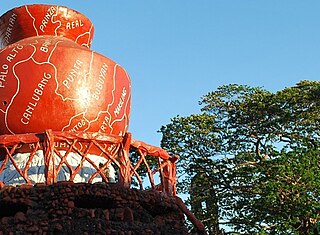| Seal of Cabuyao | |
|---|---|
 | |
| Armiger | Cabuyao |
| Adopted | August 14, 2013 (earlier versions in unknown year, 1992, and 1994) |
| Motto | Lungsod ng Cabuyao (City of Cabuyao) |
The Seal of Cabuyao is one of the official symbols of the city of Cabuyao.
| Seal of Cabuyao | |
|---|---|
 | |
| Armiger | Cabuyao |
| Adopted | August 14, 2013 (earlier versions in unknown year, 1992, and 1994) |
| Motto | Lungsod ng Cabuyao (City of Cabuyao) |
The Seal of Cabuyao is one of the official symbols of the city of Cabuyao.

During the Spanish era, when Cabuyao was still known as Tabuko uses a symbol for registration with the municipal government. The symbol has a "TAB" monogram, the first three letters of Cabuyao's old name. It is seen in branding iron for livestock branding. [1]
From an undetermined point in history until 1992, the town of Cabuyao used a seal which features a church bell. The bell represents a Golden Church bell which is deemed an inseparable part of the town's history and serves as a reminder to its denizens. The design was the outcome of a seal designing competition during the administration of Councilor Carlito Alegre and his colleagues. [1]
A competition for a new seal for Cabuyao was held. The design of Domingo Alconaba, a native painter of the then town of Cabuyao was chosen. It was adopted as the official seal by the virtue of Municipal Resolution No. 165-1993 which was authored by Municipal Council member, Dionisio S. Punongbayan. Alconaba's design featured the following elements: [1]
From 1994 until Cabuyao became a city, the seal used for the town was different from the one approved by the Office of the President through the National Historical Institute. The current seal which is being used by the City Government of Cabuyao is adapted from the old official seal of the then municipality of Cabuyao which was designed and envisioned by Domingo Alconaba, a native painter of the city. The design was chosen by the then Municipal Government during a seal making competition held in 1993. Through Municipal Resolution No. 070-2011 passed on May 18, 2011 and authored by Municipal Council member Ismael M. Hemedes, it was agreed upon by the Municipal Council of Cabuyao, to use the pre-cityhood seal until Cabuyao officially become a city. [1]
Through City Resolution No. 2013-402 filed by Hemedes, and agreed upon by the council, the current seal was adopted on August 14, 2013. The seal was revised due to the result of the combined suggestions and ideas by members of the City Council, which they believe aligns to the city's current development at that time. [1] The elements inside the circular band were placed inside a shield. The words "SAGISAG NG CABUYAO, LAGUNA" was replaced with "LUNGSOD NG CABUYAO" and "1571" was relocated to be placed inside the church bell. It was now occupied by "2012".

Muntinlupa, officially the City of Muntinlupa, is a 1st class highly urbanized city in the National Capital Region of the Philippines. According to the 2020 census, it has a population of 543,445 people.

Laguna, officially the Province of Laguna, is a province in the Philippines located in the Calabarzon region in Luzon. Its capital is Santa Cruz while its largest city is the City of Calamba and the province is situated southeast of Metro Manila, south of the province of Rizal, west of Quezon, north of Batangas and east of Cavite. Laguna hugs the southern shores of Laguna de Bay, the largest lake in the country. As of the 2020 census, the province's total population is 3,382,193. It is the seventh richest province in the country.

The coat of arms of the Philippines features the eight-rayed sun of the Philippines with each ray representing the eight provinces which were placed under martial law by Governor-General Ramón Blanco Sr. during the Philippine Revolution, and the three five-pointed stars representing the three major island groups of Luzon, the Visayas, and Mindanao.

San Pablo, officially the City of San Pablo, is a 1st class component city in the province of Laguna, Philippines. According to the 2020 census, it has a population of 285,348 people.

San Pedro, officially the City of San Pedro, is a 1st class component city in the province of Laguna, Philippines. According to the 2020 census, it has a population of 326,001 people.

Calamba, officially the City of Calamba, is a 1st class component city in the province of Laguna, Philippines. According to the 2020 census, it has a population of 539,671 people.

Santa Rosa, officially the City of Santa Rosa, is a 1st class component city in the province of Laguna, Philippines. According to the 2020 census, its population was 414,812 people.

Liliw, officially the Municipality of Liliw, is a 4th class municipality in the province of Laguna, Philippines. According to the 2020 census, it has a population of 39,491 people.

Biñan, officially the City of Biñan, is a 1st class component city in the province of Laguna, Philippines. According to the 2020 census, it has a population of 407,437 people.

Pila, officially the Municipality of Pila, is a 3rd class municipality in the province of Laguna, Philippines. According to the 2020 census, it has a population of 54,613 people.

Cabuyao, officially the City of Cabuyao, is a 1st class component city in the province of Laguna, Philippines. According to the 2020 census, it has a population of 355,330 people.

Tumauini, officially the Municipality of Tumauini, is a 1st class municipality in the province of Isabela, Philippines. According to the 2020 census, it has a population of 70,743 people.

The University of Cabuyao or Pamantasan ng Cabuyao (PnC) is a university in the city of Cabuyao, province of Laguna, Philippines. It was founded by then Mayor Etok Aguillo, through the enactment of Municipal Ordinance 2003-059 approved on April 16, 2003.
The mayor of Cabuyao is the highest ranking-officer and serves as the chief executive of the city. He enforces all laws and ordinances relative to the governance of the city and in the exercise of its appropriate corporate powers, as well as implements all approved policies, programs, projects, services and activities of the city. The mayor has a term of office of three years, but has a maximum electoral tenure of three consecutive terms.
Local elections were held in Cabuyao on May 13, 2013 within the Philippine general election. The total number of voters registered in the City of Cabuyao is 135,713 in 586 voting precincts. The voters elected for the elective local posts in the city: the mayor, vice mayor, and ten councilors.
Isidro Lebrilla Hemedes Jr. is a Filipino politician who served as the mayor of Cabuyao from 2007 until 2016. He previously served as a municipal councilor of Cabuyao from 1998 to 2001, and municipal vice-mayor from 2001 to 2007.
Nila Garcia Aguillo was a Filipino politician served as the mayor of Cabuyao from 2004 until 2007. She was the wife of former Mayor Proceso D. Aguillo, who served from 1995 to 2004.

The Church of Pila,also known as the San Antonio de Padua Parish Church, is a church dedicated to Saint Anthony of Padua in the Philippines in 1578 and the first Antonine parish church in the Philippines in 1581 and probably in Asia. It is also designated as the National Shrine of San Antonio de Padua of the Catholic Bishops' Conference of the Philippines on April 23, 2019. In 1606 the Franciscans set up the second printing press of the Philippines under the supervision of Tomás Pinpín and Domingo Loag. Its titular is Anthony of Padua, whose feast is celebrated every June 13.

Cuartel de Santo Domingo, also known as Fort Sto. Domingo and Intramuros of Sta. Rosa, is an old two-storey Spanish barracks building in Santa Rosa, Laguna in the Philippines. It is currently used as the headquarters of the Special Action Force of the Philippine National Police.

Local elections was held in the Province of Laguna on May 13, 2019 as part of the 2019 Philippine general election. Voters selected candidates for all local positions: a town mayor, vice mayor and town council, as well as members of the Sangguniang Panlalawigan, the vice-governor, governor and representatives for the four districts of Laguna, including Biñan lone district and the newly created Calamba lone district.